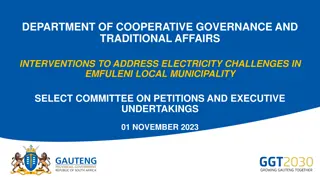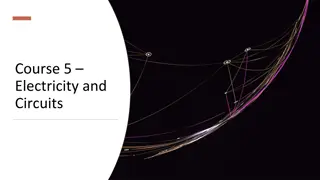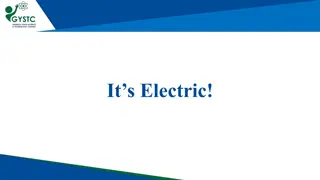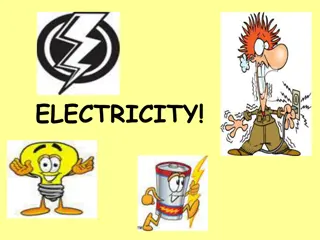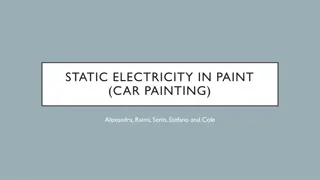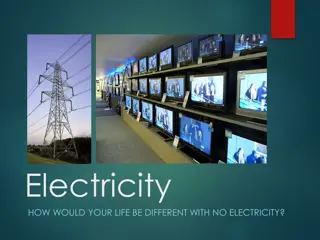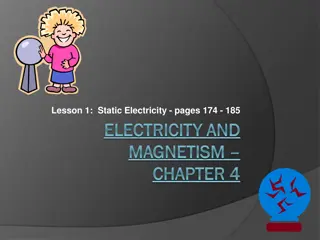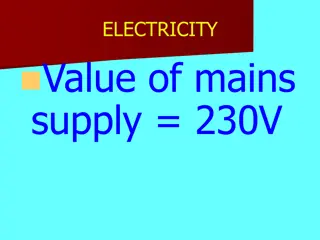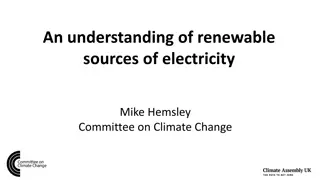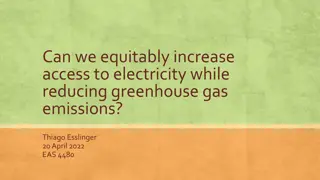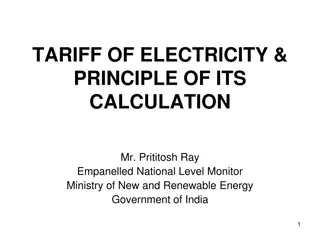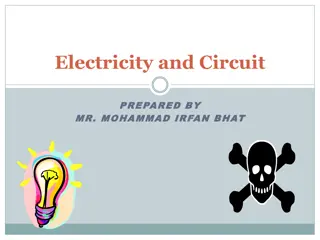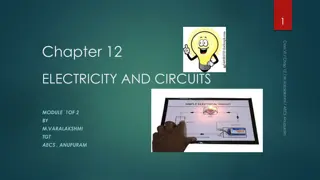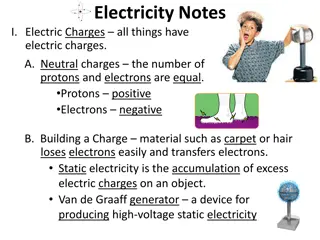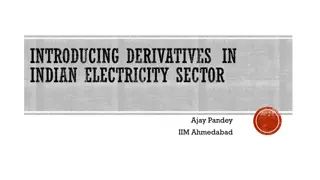Electricity in the Home
Explore the basics of using electricity in a household, covering topics such as work, energy, power consumption, meter reading, efficiency, household wiring, and safety measures. Learn about kilowatt-hours, voltage, current, and the potential dangers of overloaded circuits. Gain insights into household energy consumption and the importance of electrical efficiency.
Download Presentation

Please find below an Image/Link to download the presentation.
The content on the website is provided AS IS for your information and personal use only. It may not be sold, licensed, or shared on other websites without obtaining consent from the author. Download presentation by click this link. If you encounter any issues during the download, it is possible that the publisher has removed the file from their server.
E N D
Presentation Transcript
Chapter 5 Using Electricity in the Home Visit www.worldofteaching.com For 100 s of free powerpoints
Work = force (Newtons) X distance (m) In order to do work a force must move through a distance. Kinetic energy involves movement or use Potential energy means that it can be used On Earth we can convert our weight in kilograms to Newtons by multiplying by 10 i.e.. One kilogram becomes 10 N
Energy = Voltage X Current X time The units for energy are joules (J) Power = energy / time Power = Voltage (v) X Current (I)
House Hold Energy Consumption Hydro bills are established by finding out how many kilowatt hours of electricity your household has used in a given time. 1 kWh = kilowatts X time (hours) 1 kWh = 1 000 Watts X 1 hour 1 kWh = 1 000 W X 3 600 seconds
Reading the Meter always use the smallest number
Efficiency This is a comparison of the amount of energy obtained as compared to the amount of energy put into the system Efficiency = energy output / energy input To convert it to a percentage just multiply the answer by 100 %
House Hold Wiring The wires coming into a house include a black, a red and a white. The black and the redwires are hot The white wire is neutral leading to a ground The black is rated as being 120 v from the neutral The red is rated as being 120 v from the neutral
Electricity Entering Your House Red = In at 120V Black = Out at 120V Potential difference = 240V
Household Wiring is in Parallel Which connecting wire, A, B, C, D, or E, will be the first to become dangerously hot if too many appliances are turned on? How can overheating be prevented, even if all the appliances in the house are turned on
Alternating Current Frequency In North America, the current alternates back and forth in what we call cycles per second 1 cycle/second = 1 Hertz Electrical frequency in North America = 60 Hz
The Service Panel Since the service panel has black, red, and white wires, the total voltage is 120 + 120 = 240 volts. The service panel usually contains circuit breakers. The breakers have either a red or a black wire attached to them. The service panel provides electricity for the branch circuits.
Usually 15 amp breaker 30 amps or greater
The Neutral Wire (White) The neutral wire is the ground Grounds protect us from electrocution Service Panel has a ground wire 3 prong plug the circular, bottom hole leads to the ground buried outside.
The Neutral Wire (White) The neutral wire is _____________ Grounds protect us from __________ Service Panel has a ______________ 3 prong plug the circular, bottom hole _________________________________.
Circuit Breakers Circuit breakers open the circuit when a current in a house wire exceeds the rated current for that circuit. The circuit breaker protects people from being electrocuted to death and protects us from burning down the house. Circuit overloads cause the generation of heat.
Circuit breakers - Details Ordinary breakers are rated as 15 amps. There are bigger breakers provided for such circuits that require 240 volts e.g.. Dryers and water heaters. Instead of circuit breakers some electrical devices have fuses. Often electric stoves have fuses.
Fuses are Older than Circuit of Breakers When ribbon carries too much current, it melts, interrupting the current.
GFCI Ground Fault Circuit Interrupter 1. Detects current differences in the neutral and hot wire 2. Should be same 3. If not, the internal breaker goes immediately 4. Can reset 5. Use near water sources where safety is concern 6. Bathroom, outdoor outlets
House Hold Wiring House hold circuits are 120 volts and are alternating current. Appliances are usually connected in parallel. The circuits are polarized. That is, the black wire is connected in a certain way and the neutral wire is connected in a certain way. Polarized plugs reduce the risk of an electrical shock by forcing electricity to flow in one general direction
Types of Plugs Used in the Home Lamp Plug or Hair Dryer (Polarized) Drier Plug or Stove Plug (Ground)
Three pronged plug The round prong is the ground The longer hole is connected to the white wire (neutral). We need this wire to complete the circuit. The shorter hole is connected to the black wire.(hot 120 Volts) The grounded plug is safer than a two pronged plug.
Grounding the Current The service panel is connected to a long metal stake that buried outside the house. If a person is electrocuted most of the current will go to ground. In much older houses the wiring is grounded on the copper water pipes.
Improperly Grounded Appliance with Short One milliampere: tingling sensation Ten milliamperes: nerves and muscles overloaded 200 milliamperes: potentially fatal; heart fibrillation 500 -1000 milliamperes: not necessarily fatal; heart will restart -- One ampere or more: burn alive
Ground Plugs Prevent You from becoming the Shortest, Easiest Path to the Ground!!
Avoid! Or.. Thou Shalt Not! Frayed electrical wires Octopus outlets Water and electrical wires Plug receptacles to protect small children Over loading electrical circuits 1. 2. 3. 4. 5.
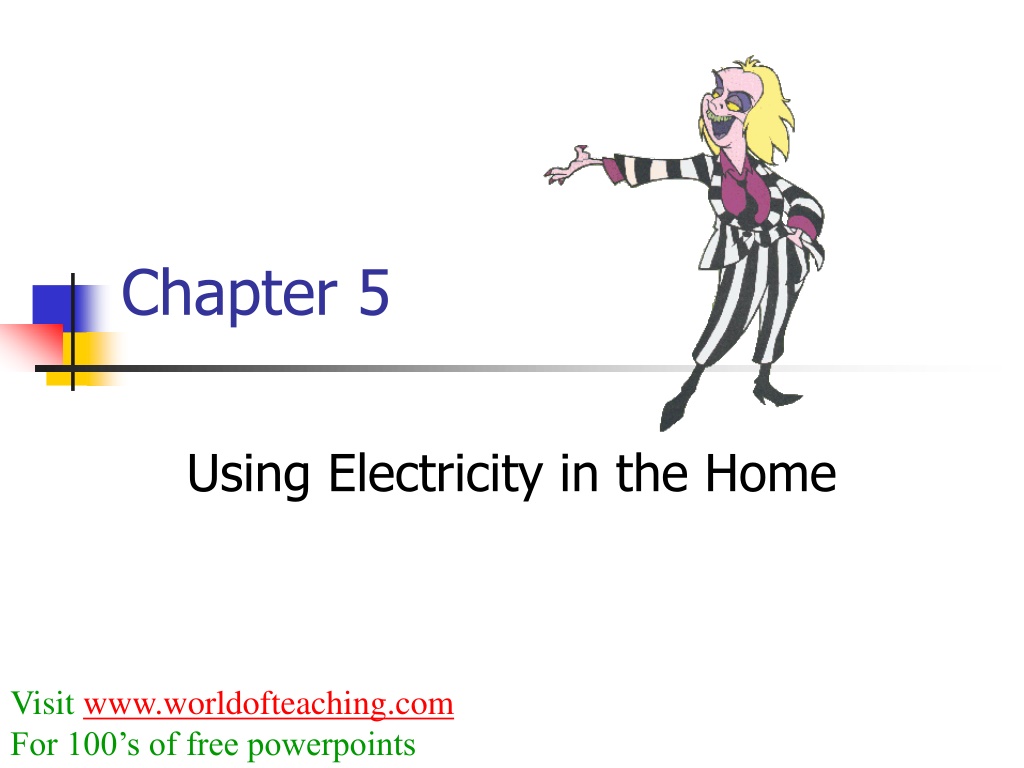
 undefined
undefined










